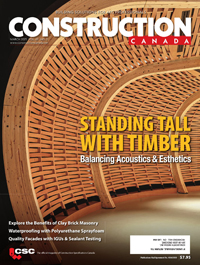Improving the performance of curtain walls
Thermal bridging and thermal barriers
While the R-value has become a very familiar measurement of thermal insulation, U-value is the key measure when it comes to glazed fenestration. R-value measures resistance to heat transfer, while U-value or ‘thermal transmittance’ measures the rate of heat transfer. Therefore, the two numbers, while not representing a direct inverse, are opposites in that a high R-value (representing a high value of insulation) and a low U-value (representing a low amount of heat and cold being transferred across a barrier) is ideal. U-values are commonly used when discussing a system of building components, as opposed to a single material.
Various types of thermal barrier can be used to maximize these values.
The ‘pour and debridge’ thermal barrier
With this method, the aluminum profile is extruded with a channel designed to hold an insulating polymer. This channel is mechanically abraded to ensure adhesion of the polymer, while a mechanical lock inside the thermal cavity locks the thermal barrier to the aluminum (Figure 1). This allows the maximum separation of the aluminum required for lower U-values, while also providing superior structural strength for the composite.
Polyurethane polymers are then poured as liquid into the thermal barrier channel, where they solidify into a structural component, and the metal floor of the cavity is removed from the bottom of the channel. After this ‘debridging,’ the unit has no continuous run of metal from the building’s interior to its exterior—the polyurethane connects the two separate sides to form a composite. As polyurethane features thermal conductivity more than 1300 times lower than that of aluminum, its thermal benefits can be achieved within a very small amount of space, although the amount of separation should be determined based on the energy efficiency requirements of a given building.
This complete separation of the aluminum profile means the structural abilities of the polymers are of critical importance, since curtain walls (especially those used on tall buildings) must provide shear and tensile strength in strong winds, or even in blast or hurricane situations. In the unitized system, thermal barriers must also accommodate stresses created by thermal expansion and pressure differences. Fortunately, polyurethane offers an exceptional amount of structural strength, particularly shear strength, allowing designers to maximize the span of glazing within the curtain wall framing.
As well as by introducing a polymer to interrupt the thermal bridge, energy efficiency can be increased by manipulating the shape of the aluminum extrusion itself. The latest developments in this area include wide-cavity and dual-cavity construction.
Creating a wider cavity in the frame allows for a lower U-value in most fenestration products. This is outlined in Figure 2, which offers a comparison of the U-value of 2.44 W/m2K (0.43 Btu/[hr-sf-F]) achievable with a thermal isolator to that of a wider cavity. By use of a polyurethane thermal barrier, the U-value can be improved to 2.00 W/m2K (0.35 Btu/[hr-sf-F]), and can be lowered further to 1.70 W/m2K (0.30 Btu/[hr-sf-F]) with the use of
performance glazing.
If one debridged cavity performs well, then two will perform even better in many instances. In dual thermal barrier systems (Figure 3), the U-value can improve by as much as 20 per cent depending on cavity size, cavity location, and fenestration type, and greater condensation resistance can also be achieved. Additionally, the dual cavity allows wider-span openings for greater glass area and, consequently, increased daylighting. Dual thermal barrier designs also allow for the use of triple glazing, for U-values of less than 1.14 W/m2K (0.20 Btu/[hr-sf-F]).
Polyamide thermal barrier strips
An alternative to the polyurethane-based pour and debridge method, polyamide barriers are pre-extruded, structural plastic insulating strips, usually featuring multi-directional glass fibre reinforcing to improve load transfer. For wall systems utilizing polyamide strips, two separate aluminum extrusions are created—one interior and one exterior—and channels are created in the aluminum profiles to hold the barrier strips. These channels must be knurled or bent to produce ‘teeth,’ which improve the assembly’s shear strength and hold the polyamide strip. Once the polyamide strip is inserted into the aluminum’s channel, the entire assembly is rolled or crimped to create the bond and turn the system into a composite.
These strips allow some of the greatest thermal separation widths available with the use of less metal, which in turn generates savings on resources. They also have a similar co-efficient of expansion and contraction to aluminum, ensuring the overall stability of the system (Figure 4).
Ongoing developments in curtain wall assemblies include alternative designs for pressure plates. Polyamide was used to develop a new pressure-plate system up to 20 per cent more efficient than earlier designs, with a 10 per cent gain in condensation resistance (Figure 5). Pressure plates with polyamide have excellent thermal values, require no special handling or fabrication, and are installed similarly to aluminum pressure plates.
The specified slider does not exist.





